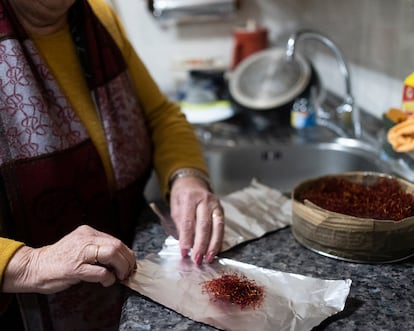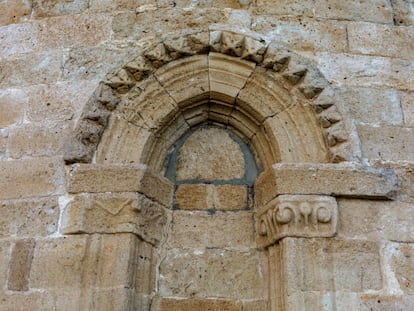How saffron turned a Spanish grandmother into a viral hit
A photo shared on Twitter of María Jiménez removing strands of the spice has received 10,800 retweets and more than 60,700 likes

In 1962, when she was 18 years old, María Jiménez worked as an assistant in a house in Munera, a small village in the province of Albacete, in Spain’s Castilla-La Mancha region. José Martínez, who was 20 at the time, would drop by to greet her in the hope of catching her eye. When they started dating, he had a very noisy bicycle, and to avoid attracting attention he would take the quieter Santana street rather than the principal Mayor street. But Santana street was more isolated and the lighting wasn’t good, and María was terrified that José would try and kiss her there. “But given the dreadful racket that that bicycle made in the end he convinced me to change streets,” she explains. “But he behaved like a perfect gentleman with me.”
Six years later they were married, but there was no honeymoon due to a lack of money and time, and three days later they bought the house they still live in “for 55,000 pesetas” – about €330 today. María, 77, is telling her story sitting in the parlor of her home, located on San José street in Munera, which is home to some 3,500 people. The property, which counts on an interior garden, has grown over the years and now covers some 600 square meters, including a small plot of land. With her is José, now 79, a retired builder but active gardener.
Just like in thousands of other houses in Castilla-La Mancha, on the television is the show En compañía (or, In company). It’s a regional production, presented by Ramón García, and according to its website is aimed at “helping to end the loneliness of residents of Castilla-La Mancha. A problem that right now affects thousands of people and is a major concern for society in the 21st century.”
Every afternoon the show travels to homes in the region “so that people who are alone can rid themselves of loneliness.” En compañía is a religion for many people, particularly in the winter when the cold weather arrives and night falls at 6pm, and there is no more company than the television or radio.

In this house, which is dotted with photos of the couple’s two children and four grandchildren, Ramón García is invited in every day to make life a little less abrasive. “I’m going to be on that show the day after tomorrow,” says María suddenly.
José and María greeted the visiting journalists from EL PAÍS with the most beautiful phrase they have ever heard, one that could be the start of a novel: “You are the ones who want to know everything about the crocus.” And it’s true: the two journalists who are on their doorstep want to know everything there is to know about the saffron flowers, the plant that María grows in her home.
Everything began on November 5 at 8pm, when María’s grandson Pedro Varea posted a photo on Twitter of her removing the strands of saffron from the flower. It became an instant viral hit.
Mi abuela estaba mondando rosa para sacar azafrán y le dijo a una mujer "pásaselas a mi nieto, que es periodista y las pondrá en algún periódico" y estoy triste porque no tengo ESE PODER y busco un periódico que quiera poner en portada a mi abuela GRATIS para hacerle feliz 😭💔 pic.twitter.com/GGiVVh7F8d
— Pedro Varea 🦕🪐 (@droncio_) November 5, 2021
“My grandmother is handpicking crocus flowers to get saffron and a woman said to her, ‘Give them to my grandson, who’s a journalist and will put them in some newspaper.’ And I’m sad because I don’t have that power and I’m looking for a newspaper who wants to put my grandma on the cover for free and make her happy,” wrote Varea, who works with the digital publication El Salto. More than 10,800 retweets and 60,700 likes later, Varea can now say that not only does he have the power to get his grandma in the newspaper, but has also managed to get her on one of her favorite TV shows.
“The whole world has been calling the house,” María explains. “Even from outside Spain. I don’t even know what Twitter is, but what a shock I got. So many people have written to us on the internet! Family, neighbors, journalists…”

“When we got married, my father gave us a saffron garden as a gift,” explains María. Back then, it would yield as much as 20 kilos of saffron. “My father would sell it of course, he was a saffron salesman,” she explains. “Some gentlemen from Albacete would come and buy it, as would Moors to use it for clothes dye.”
Once the saffron has been extracted, it has to be toasted. María crushes it with a pestle and mortar and usually uses it in her paellas, cocidos and stews. José removes the crocus flowers from their garden carefully. The plant, which has six large purple petals, yields the so-called “red gold” – the saffron is known as such thanks to its beauty and of course its price. A gram of the strands can be sold for between €8 and €10, and as much as €8,000 to €10,000 when sold wholesale.
The sun is setting in Munera and a windmill located next to two sculptures of Don Quixote and Sancho Panza are visible against the orange sky. Earlier this year, an attorney named Francisco José Valera and cartographer Álvaro Anguix published an essay in which they argued that Munera is the place in La Mancha “whose name I do not care to remember,” according to the opening lines of Miguel Cervantes’ novel, the most famous and influential in history. The apparent revelation caused widespread debate and left just one conclusion: the setting of Don Quixote remains a mystery. It could be Munera, it could not.
These days, Munera is just another village that is trying to cope with the unstoppable advance of the so-called “empty Spain,” a phenomenon whereby rural areas suffer from increasing depopulation and the problems it brings with it. But María and José, who have seen their siblings, children and grandchildren all leave to seek “another life,” are not going anywhere. They were born, will live and will die here.
They spent the coronavirus lockdown here, saved by the interior courtyard, the phone and the television. This is a place where a cherry tree, a rose bush, a pomegranate tree and a medlar tree all grow, and where the saffron emits a hypnotic smell.
For family reunions, such as those planned for the upcoming holiday season, José uses an oven that he built to bake bread, roast lamb or prepare desserts. Before she says goodbye, she shows some of the last coal collected by her father, who became a coalman after his time selling saffron. She has held on to it, as a memory of a world that is slowly disappearing. José, meanwhile, opens up a huge garage in which he keeps all kinds of machines, tools, contraptions, old motorbikes… Does he still have that noisy bicycle, the one that 60 years ago prompted the couple to take a darker, quieter street? The man starts to laugh.
Tu suscripción se está usando en otro dispositivo
¿Quieres añadir otro usuario a tu suscripción?
Si continúas leyendo en este dispositivo, no se podrá leer en el otro.
FlechaTu suscripción se está usando en otro dispositivo y solo puedes acceder a EL PAÍS desde un dispositivo a la vez.
Si quieres compartir tu cuenta, cambia tu suscripción a la modalidad Premium, así podrás añadir otro usuario. Cada uno accederá con su propia cuenta de email, lo que os permitirá personalizar vuestra experiencia en EL PAÍS.
¿Tienes una suscripción de empresa? Accede aquí para contratar más cuentas.
En el caso de no saber quién está usando tu cuenta, te recomendamos cambiar tu contraseña aquí.
Si decides continuar compartiendo tu cuenta, este mensaje se mostrará en tu dispositivo y en el de la otra persona que está usando tu cuenta de forma indefinida, afectando a tu experiencia de lectura. Puedes consultar aquí los términos y condiciones de la suscripción digital.
More information
Últimas noticias
Sydney Sweeney, the actress praised by Trump: ‘Women are up against what society wants them to be’
The Bolsonaro surname: An advantage or liability in Brazil’s 2026 presidential elections?
Raúl Rocha, from jet-setting with Miss Universe to arms trafficking and fuel theft
80,000 barrels of Mexican oil sent to Cuba: Havana drawn into the US–Mexico clash
Most viewed
- Reinhard Genzel, Nobel laureate in physics: ‘One-minute videos will never give you the truth’
- Pablo Escobar’s hippos: A serious environmental problem, 40 years on
- Charles Dubouloz, mountaineering star, retires at 36 with a farewell tour inspired by Walter Bonatti
- Why we lost the habit of sleeping in two segments and how that changed our sense of time
- The fall of a prolific science journal exposes the billion-dollar profits of scientific publishing











































